Managing Innovation and Continuous Improvement at AC Gilbert: A Report
VerifiedAdded on 2020/04/15
|13
|2792
|229
Report
AI Summary
This report examines the innovation and continuous improvement strategies implemented at AC Gilbert, focusing on key systems, processes, and performance monitoring. It analyzes the company's supply chain, operational systems, and product delivery, highlighting the importance of customer interaction and adapting to market trends. The report discusses ways to monitor performance, analyze variances, and incorporate specialist advice. It then develops options for continuous improvement, including performance improvement strategies, minute management team briefings, and leading sessions to gather ideas. Furthermore, it delves into risk analysis and cost-benefit analysis strategies. Finally, the report examines the implementation of innovative processes, including action plans and contingency plans, and discusses implementation issues and failures, concluding with recommendations for amending plans and schedules.
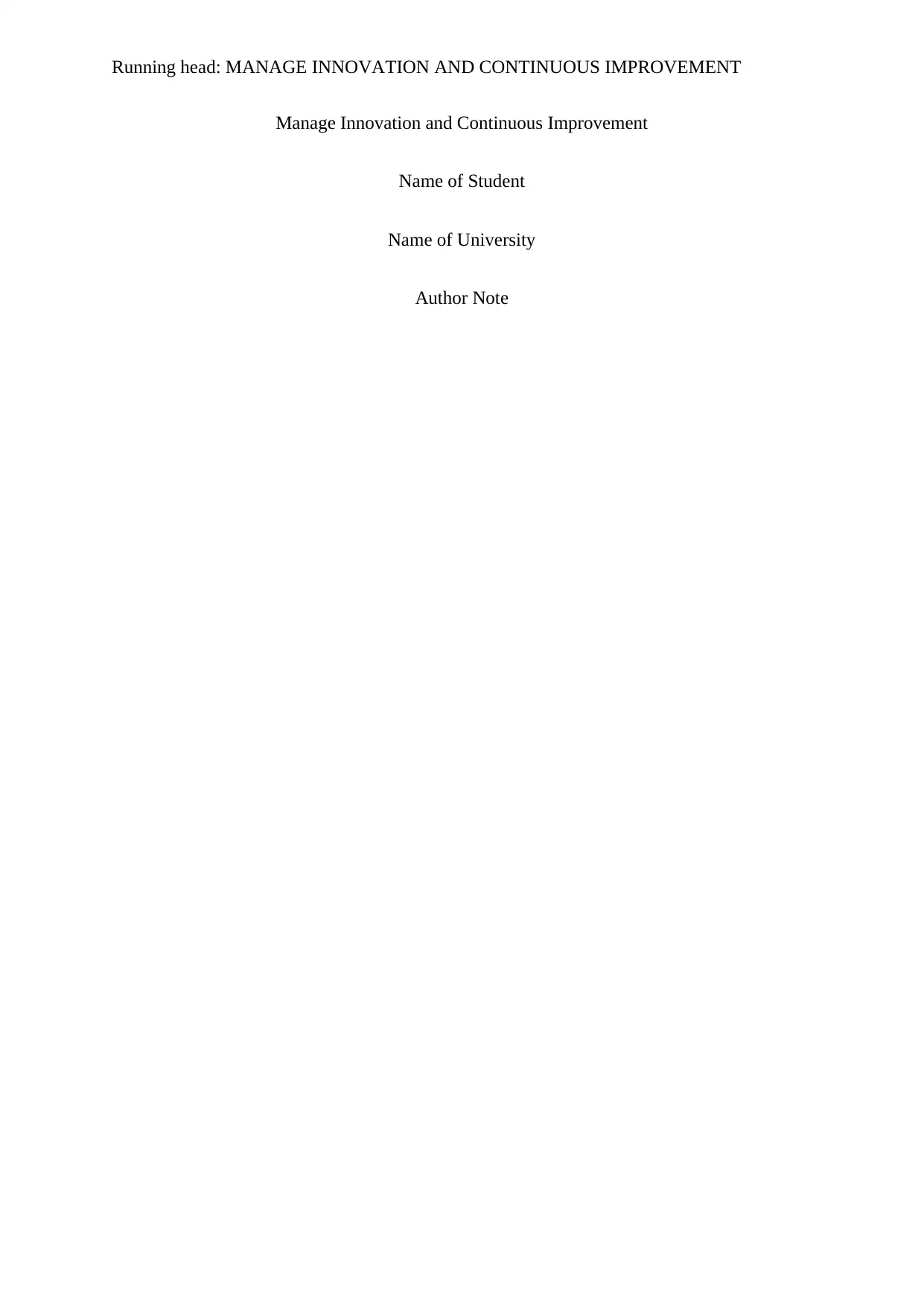
Running head: MANAGE INNOVATION AND CONTINUOUS IMPROVEMENT
Manage Innovation and Continuous Improvement
Name of Student
Name of University
Author Note
Manage Innovation and Continuous Improvement
Name of Student
Name of University
Author Note
Paraphrase This Document
Need a fresh take? Get an instant paraphrase of this document with our AI Paraphraser
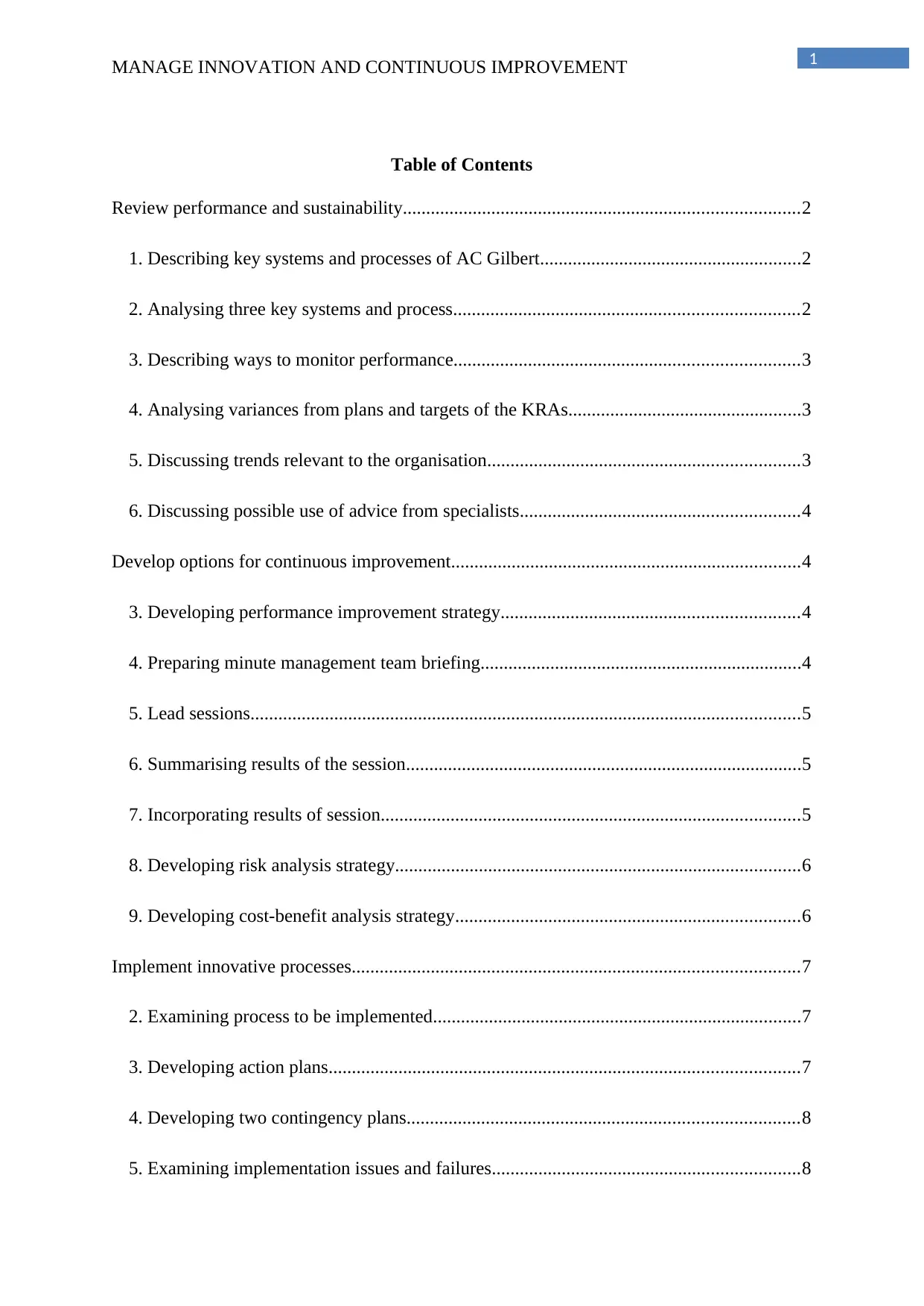
1
MANAGE INNOVATION AND CONTINUOUS IMPROVEMENT
Table of Contents
Review performance and sustainability.....................................................................................2
1. Describing key systems and processes of AC Gilbert........................................................2
2. Analysing three key systems and process..........................................................................2
3. Describing ways to monitor performance..........................................................................3
4. Analysing variances from plans and targets of the KRAs..................................................3
5. Discussing trends relevant to the organisation...................................................................3
6. Discussing possible use of advice from specialists............................................................4
Develop options for continuous improvement...........................................................................4
3. Developing performance improvement strategy................................................................4
4. Preparing minute management team briefing.....................................................................4
5. Lead sessions......................................................................................................................5
6. Summarising results of the session.....................................................................................5
7. Incorporating results of session..........................................................................................5
8. Developing risk analysis strategy.......................................................................................6
9. Developing cost-benefit analysis strategy..........................................................................6
Implement innovative processes................................................................................................7
2. Examining process to be implemented...............................................................................7
3. Developing action plans.....................................................................................................7
4. Developing two contingency plans....................................................................................8
5. Examining implementation issues and failures..................................................................8
MANAGE INNOVATION AND CONTINUOUS IMPROVEMENT
Table of Contents
Review performance and sustainability.....................................................................................2
1. Describing key systems and processes of AC Gilbert........................................................2
2. Analysing three key systems and process..........................................................................2
3. Describing ways to monitor performance..........................................................................3
4. Analysing variances from plans and targets of the KRAs..................................................3
5. Discussing trends relevant to the organisation...................................................................3
6. Discussing possible use of advice from specialists............................................................4
Develop options for continuous improvement...........................................................................4
3. Developing performance improvement strategy................................................................4
4. Preparing minute management team briefing.....................................................................4
5. Lead sessions......................................................................................................................5
6. Summarising results of the session.....................................................................................5
7. Incorporating results of session..........................................................................................5
8. Developing risk analysis strategy.......................................................................................6
9. Developing cost-benefit analysis strategy..........................................................................6
Implement innovative processes................................................................................................7
2. Examining process to be implemented...............................................................................7
3. Developing action plans.....................................................................................................7
4. Developing two contingency plans....................................................................................8
5. Examining implementation issues and failures..................................................................8
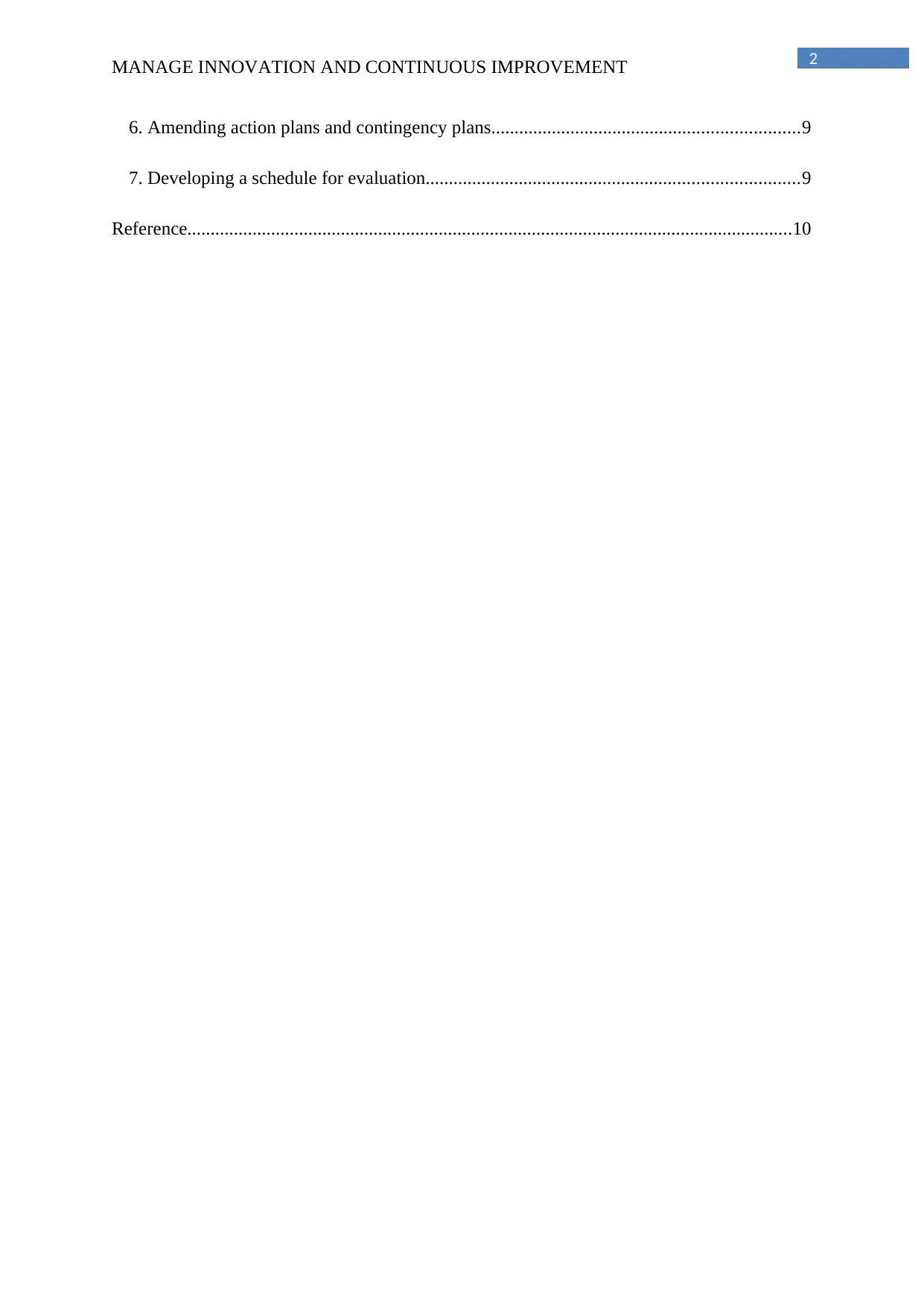
2
MANAGE INNOVATION AND CONTINUOUS IMPROVEMENT
6. Amending action plans and contingency plans..................................................................9
7. Developing a schedule for evaluation................................................................................9
Reference..................................................................................................................................10
MANAGE INNOVATION AND CONTINUOUS IMPROVEMENT
6. Amending action plans and contingency plans..................................................................9
7. Developing a schedule for evaluation................................................................................9
Reference..................................................................................................................................10
⊘ This is a preview!⊘
Do you want full access?
Subscribe today to unlock all pages.

Trusted by 1+ million students worldwide
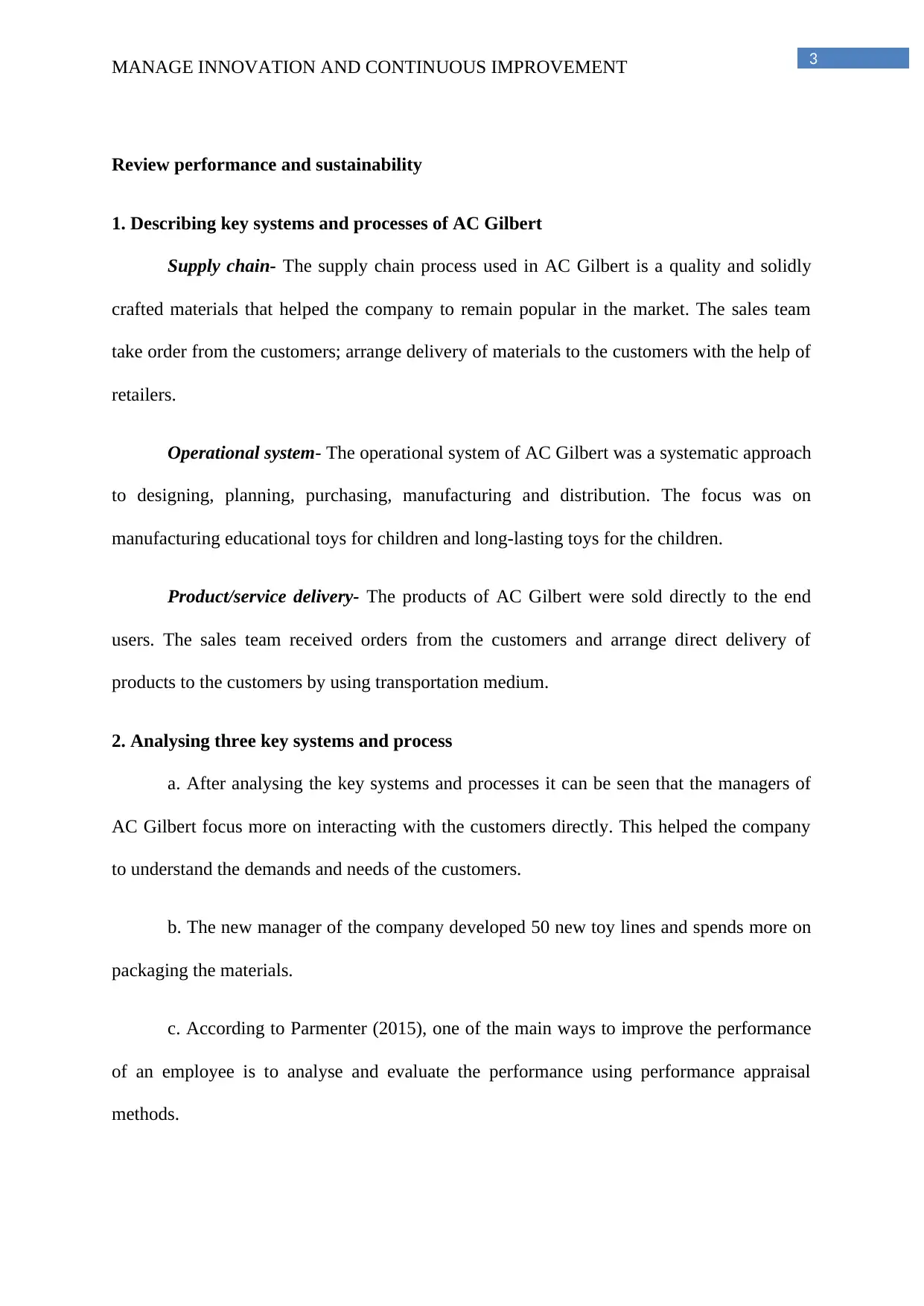
3
MANAGE INNOVATION AND CONTINUOUS IMPROVEMENT
Review performance and sustainability
1. Describing key systems and processes of AC Gilbert
Supply chain- The supply chain process used in AC Gilbert is a quality and solidly
crafted materials that helped the company to remain popular in the market. The sales team
take order from the customers; arrange delivery of materials to the customers with the help of
retailers.
Operational system- The operational system of AC Gilbert was a systematic approach
to designing, planning, purchasing, manufacturing and distribution. The focus was on
manufacturing educational toys for children and long-lasting toys for the children.
Product/service delivery- The products of AC Gilbert were sold directly to the end
users. The sales team received orders from the customers and arrange direct delivery of
products to the customers by using transportation medium.
2. Analysing three key systems and process
a. After analysing the key systems and processes it can be seen that the managers of
AC Gilbert focus more on interacting with the customers directly. This helped the company
to understand the demands and needs of the customers.
b. The new manager of the company developed 50 new toy lines and spends more on
packaging the materials.
c. According to Parmenter (2015), one of the main ways to improve the performance
of an employee is to analyse and evaluate the performance using performance appraisal
methods.
MANAGE INNOVATION AND CONTINUOUS IMPROVEMENT
Review performance and sustainability
1. Describing key systems and processes of AC Gilbert
Supply chain- The supply chain process used in AC Gilbert is a quality and solidly
crafted materials that helped the company to remain popular in the market. The sales team
take order from the customers; arrange delivery of materials to the customers with the help of
retailers.
Operational system- The operational system of AC Gilbert was a systematic approach
to designing, planning, purchasing, manufacturing and distribution. The focus was on
manufacturing educational toys for children and long-lasting toys for the children.
Product/service delivery- The products of AC Gilbert were sold directly to the end
users. The sales team received orders from the customers and arrange direct delivery of
products to the customers by using transportation medium.
2. Analysing three key systems and process
a. After analysing the key systems and processes it can be seen that the managers of
AC Gilbert focus more on interacting with the customers directly. This helped the company
to understand the demands and needs of the customers.
b. The new manager of the company developed 50 new toy lines and spends more on
packaging the materials.
c. According to Parmenter (2015), one of the main ways to improve the performance
of an employee is to analyse and evaluate the performance using performance appraisal
methods.
Paraphrase This Document
Need a fresh take? Get an instant paraphrase of this document with our AI Paraphraser
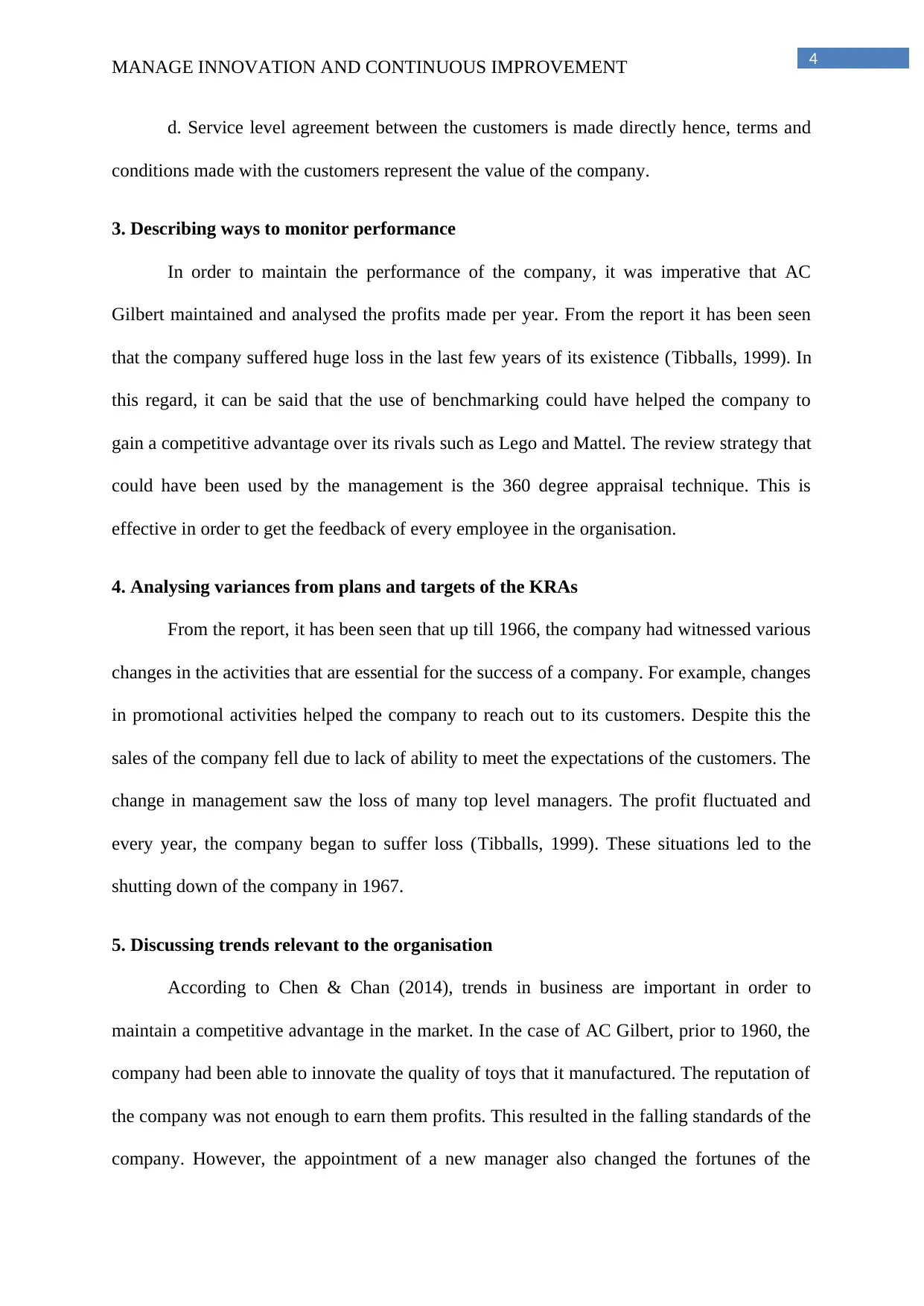
4
MANAGE INNOVATION AND CONTINUOUS IMPROVEMENT
d. Service level agreement between the customers is made directly hence, terms and
conditions made with the customers represent the value of the company.
3. Describing ways to monitor performance
In order to maintain the performance of the company, it was imperative that AC
Gilbert maintained and analysed the profits made per year. From the report it has been seen
that the company suffered huge loss in the last few years of its existence (Tibballs, 1999). In
this regard, it can be said that the use of benchmarking could have helped the company to
gain a competitive advantage over its rivals such as Lego and Mattel. The review strategy that
could have been used by the management is the 360 degree appraisal technique. This is
effective in order to get the feedback of every employee in the organisation.
4. Analysing variances from plans and targets of the KRAs
From the report, it has been seen that up till 1966, the company had witnessed various
changes in the activities that are essential for the success of a company. For example, changes
in promotional activities helped the company to reach out to its customers. Despite this the
sales of the company fell due to lack of ability to meet the expectations of the customers. The
change in management saw the loss of many top level managers. The profit fluctuated and
every year, the company began to suffer loss (Tibballs, 1999). These situations led to the
shutting down of the company in 1967.
5. Discussing trends relevant to the organisation
According to Chen & Chan (2014), trends in business are important in order to
maintain a competitive advantage in the market. In the case of AC Gilbert, prior to 1960, the
company had been able to innovate the quality of toys that it manufactured. The reputation of
the company was not enough to earn them profits. This resulted in the falling standards of the
company. However, the appointment of a new manager also changed the fortunes of the
MANAGE INNOVATION AND CONTINUOUS IMPROVEMENT
d. Service level agreement between the customers is made directly hence, terms and
conditions made with the customers represent the value of the company.
3. Describing ways to monitor performance
In order to maintain the performance of the company, it was imperative that AC
Gilbert maintained and analysed the profits made per year. From the report it has been seen
that the company suffered huge loss in the last few years of its existence (Tibballs, 1999). In
this regard, it can be said that the use of benchmarking could have helped the company to
gain a competitive advantage over its rivals such as Lego and Mattel. The review strategy that
could have been used by the management is the 360 degree appraisal technique. This is
effective in order to get the feedback of every employee in the organisation.
4. Analysing variances from plans and targets of the KRAs
From the report, it has been seen that up till 1966, the company had witnessed various
changes in the activities that are essential for the success of a company. For example, changes
in promotional activities helped the company to reach out to its customers. Despite this the
sales of the company fell due to lack of ability to meet the expectations of the customers. The
change in management saw the loss of many top level managers. The profit fluctuated and
every year, the company began to suffer loss (Tibballs, 1999). These situations led to the
shutting down of the company in 1967.
5. Discussing trends relevant to the organisation
According to Chen & Chan (2014), trends in business are important in order to
maintain a competitive advantage in the market. In the case of AC Gilbert, prior to 1960, the
company had been able to innovate the quality of toys that it manufactured. The reputation of
the company was not enough to earn them profits. This resulted in the falling standards of the
company. However, the appointment of a new manager also changed the fortunes of the
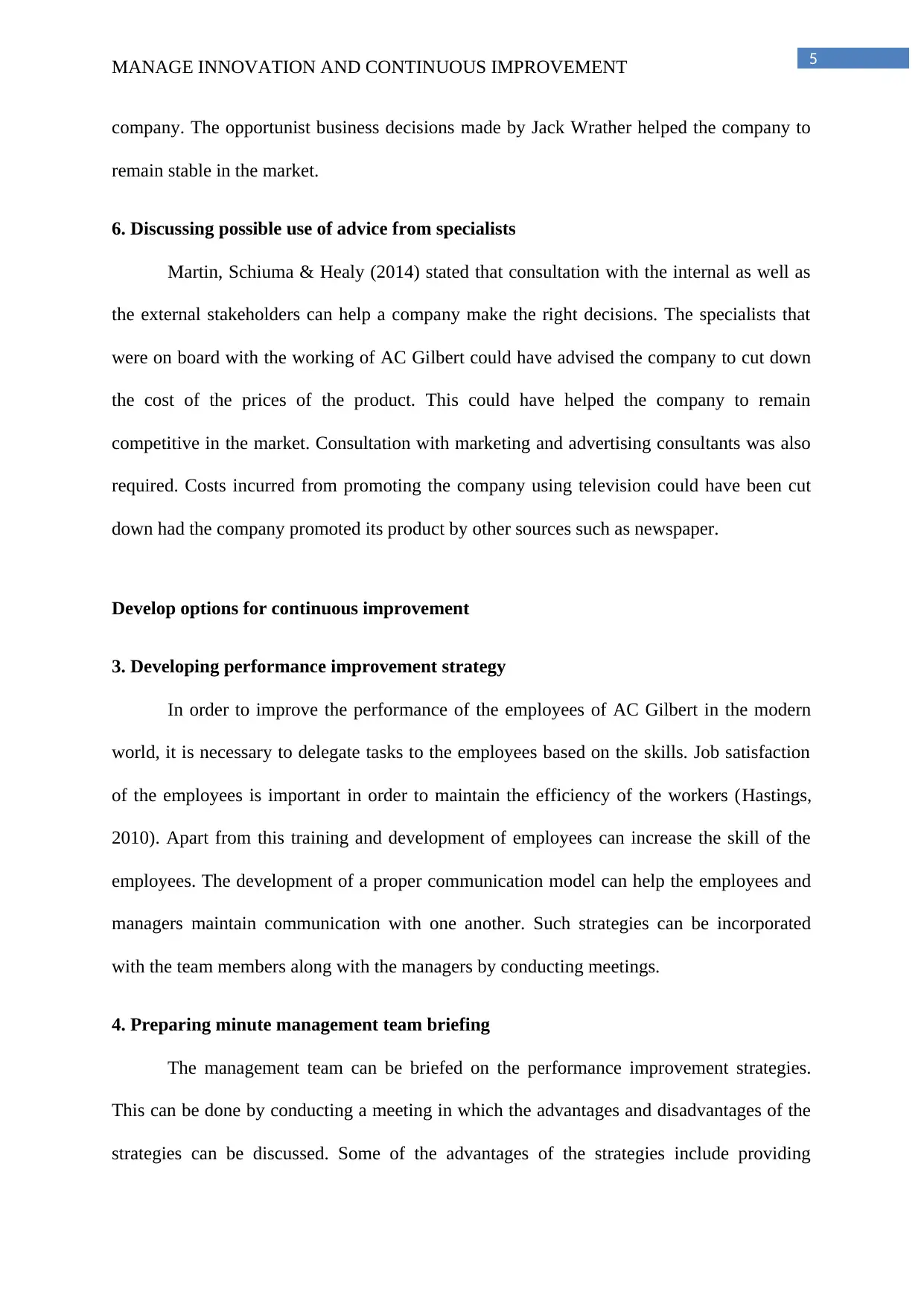
5
MANAGE INNOVATION AND CONTINUOUS IMPROVEMENT
company. The opportunist business decisions made by Jack Wrather helped the company to
remain stable in the market.
6. Discussing possible use of advice from specialists
Martin, Schiuma & Healy (2014) stated that consultation with the internal as well as
the external stakeholders can help a company make the right decisions. The specialists that
were on board with the working of AC Gilbert could have advised the company to cut down
the cost of the prices of the product. This could have helped the company to remain
competitive in the market. Consultation with marketing and advertising consultants was also
required. Costs incurred from promoting the company using television could have been cut
down had the company promoted its product by other sources such as newspaper.
Develop options for continuous improvement
3. Developing performance improvement strategy
In order to improve the performance of the employees of AC Gilbert in the modern
world, it is necessary to delegate tasks to the employees based on the skills. Job satisfaction
of the employees is important in order to maintain the efficiency of the workers (Hastings,
2010). Apart from this training and development of employees can increase the skill of the
employees. The development of a proper communication model can help the employees and
managers maintain communication with one another. Such strategies can be incorporated
with the team members along with the managers by conducting meetings.
4. Preparing minute management team briefing
The management team can be briefed on the performance improvement strategies.
This can be done by conducting a meeting in which the advantages and disadvantages of the
strategies can be discussed. Some of the advantages of the strategies include providing
MANAGE INNOVATION AND CONTINUOUS IMPROVEMENT
company. The opportunist business decisions made by Jack Wrather helped the company to
remain stable in the market.
6. Discussing possible use of advice from specialists
Martin, Schiuma & Healy (2014) stated that consultation with the internal as well as
the external stakeholders can help a company make the right decisions. The specialists that
were on board with the working of AC Gilbert could have advised the company to cut down
the cost of the prices of the product. This could have helped the company to remain
competitive in the market. Consultation with marketing and advertising consultants was also
required. Costs incurred from promoting the company using television could have been cut
down had the company promoted its product by other sources such as newspaper.
Develop options for continuous improvement
3. Developing performance improvement strategy
In order to improve the performance of the employees of AC Gilbert in the modern
world, it is necessary to delegate tasks to the employees based on the skills. Job satisfaction
of the employees is important in order to maintain the efficiency of the workers (Hastings,
2010). Apart from this training and development of employees can increase the skill of the
employees. The development of a proper communication model can help the employees and
managers maintain communication with one another. Such strategies can be incorporated
with the team members along with the managers by conducting meetings.
4. Preparing minute management team briefing
The management team can be briefed on the performance improvement strategies.
This can be done by conducting a meeting in which the advantages and disadvantages of the
strategies can be discussed. Some of the advantages of the strategies include providing
⊘ This is a preview!⊘
Do you want full access?
Subscribe today to unlock all pages.

Trusted by 1+ million students worldwide
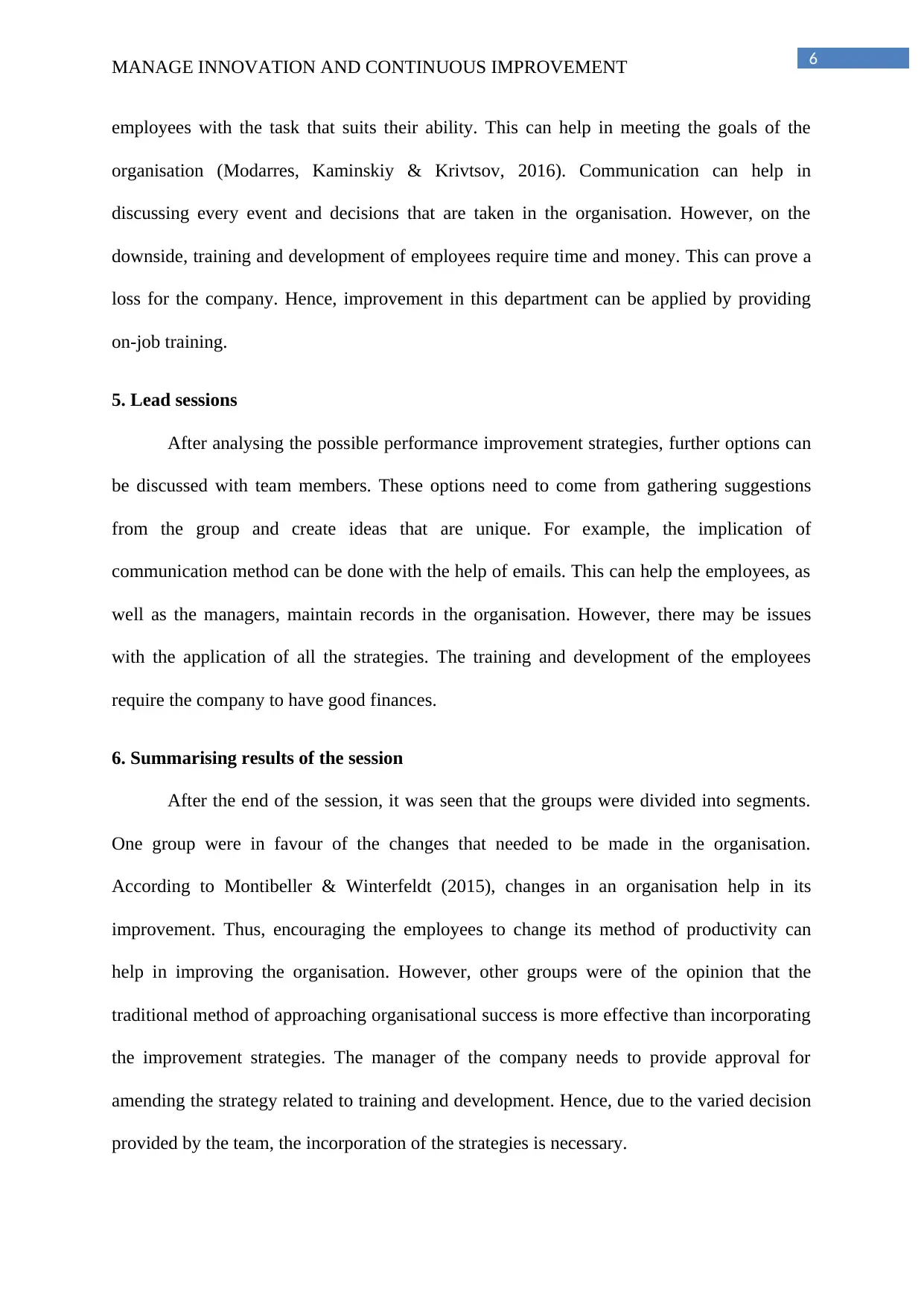
6
MANAGE INNOVATION AND CONTINUOUS IMPROVEMENT
employees with the task that suits their ability. This can help in meeting the goals of the
organisation (Modarres, Kaminskiy & Krivtsov, 2016). Communication can help in
discussing every event and decisions that are taken in the organisation. However, on the
downside, training and development of employees require time and money. This can prove a
loss for the company. Hence, improvement in this department can be applied by providing
on-job training.
5. Lead sessions
After analysing the possible performance improvement strategies, further options can
be discussed with team members. These options need to come from gathering suggestions
from the group and create ideas that are unique. For example, the implication of
communication method can be done with the help of emails. This can help the employees, as
well as the managers, maintain records in the organisation. However, there may be issues
with the application of all the strategies. The training and development of the employees
require the company to have good finances.
6. Summarising results of the session
After the end of the session, it was seen that the groups were divided into segments.
One group were in favour of the changes that needed to be made in the organisation.
According to Montibeller & Winterfeldt (2015), changes in an organisation help in its
improvement. Thus, encouraging the employees to change its method of productivity can
help in improving the organisation. However, other groups were of the opinion that the
traditional method of approaching organisational success is more effective than incorporating
the improvement strategies. The manager of the company needs to provide approval for
amending the strategy related to training and development. Hence, due to the varied decision
provided by the team, the incorporation of the strategies is necessary.
MANAGE INNOVATION AND CONTINUOUS IMPROVEMENT
employees with the task that suits their ability. This can help in meeting the goals of the
organisation (Modarres, Kaminskiy & Krivtsov, 2016). Communication can help in
discussing every event and decisions that are taken in the organisation. However, on the
downside, training and development of employees require time and money. This can prove a
loss for the company. Hence, improvement in this department can be applied by providing
on-job training.
5. Lead sessions
After analysing the possible performance improvement strategies, further options can
be discussed with team members. These options need to come from gathering suggestions
from the group and create ideas that are unique. For example, the implication of
communication method can be done with the help of emails. This can help the employees, as
well as the managers, maintain records in the organisation. However, there may be issues
with the application of all the strategies. The training and development of the employees
require the company to have good finances.
6. Summarising results of the session
After the end of the session, it was seen that the groups were divided into segments.
One group were in favour of the changes that needed to be made in the organisation.
According to Montibeller & Winterfeldt (2015), changes in an organisation help in its
improvement. Thus, encouraging the employees to change its method of productivity can
help in improving the organisation. However, other groups were of the opinion that the
traditional method of approaching organisational success is more effective than incorporating
the improvement strategies. The manager of the company needs to provide approval for
amending the strategy related to training and development. Hence, due to the varied decision
provided by the team, the incorporation of the strategies is necessary.
Paraphrase This Document
Need a fresh take? Get an instant paraphrase of this document with our AI Paraphraser
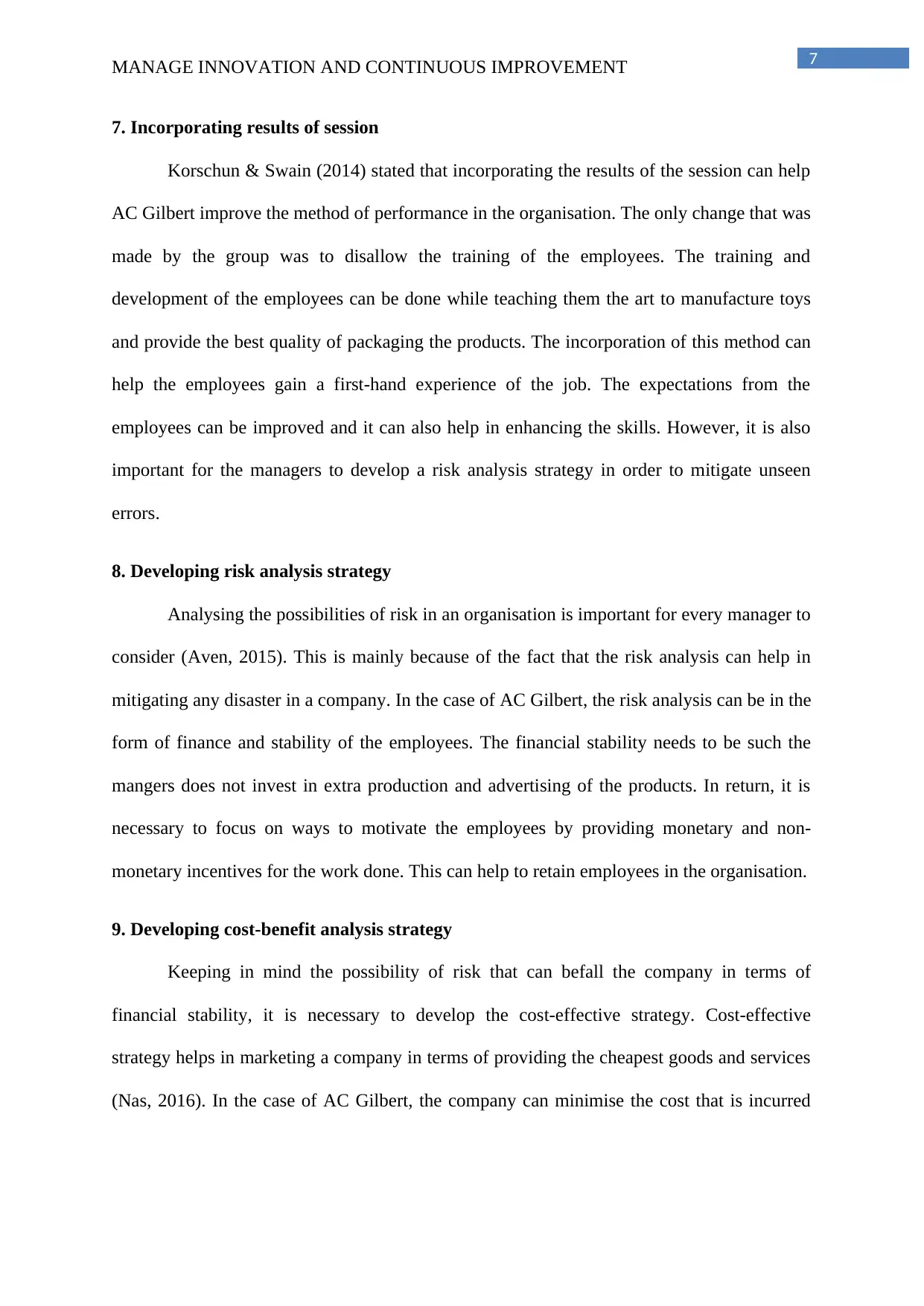
7
MANAGE INNOVATION AND CONTINUOUS IMPROVEMENT
7. Incorporating results of session
Korschun & Swain (2014) stated that incorporating the results of the session can help
AC Gilbert improve the method of performance in the organisation. The only change that was
made by the group was to disallow the training of the employees. The training and
development of the employees can be done while teaching them the art to manufacture toys
and provide the best quality of packaging the products. The incorporation of this method can
help the employees gain a first-hand experience of the job. The expectations from the
employees can be improved and it can also help in enhancing the skills. However, it is also
important for the managers to develop a risk analysis strategy in order to mitigate unseen
errors.
8. Developing risk analysis strategy
Analysing the possibilities of risk in an organisation is important for every manager to
consider (Aven, 2015). This is mainly because of the fact that the risk analysis can help in
mitigating any disaster in a company. In the case of AC Gilbert, the risk analysis can be in the
form of finance and stability of the employees. The financial stability needs to be such the
mangers does not invest in extra production and advertising of the products. In return, it is
necessary to focus on ways to motivate the employees by providing monetary and non-
monetary incentives for the work done. This can help to retain employees in the organisation.
9. Developing cost-benefit analysis strategy
Keeping in mind the possibility of risk that can befall the company in terms of
financial stability, it is necessary to develop the cost-effective strategy. Cost-effective
strategy helps in marketing a company in terms of providing the cheapest goods and services
(Nas, 2016). In the case of AC Gilbert, the company can minimise the cost that is incurred
MANAGE INNOVATION AND CONTINUOUS IMPROVEMENT
7. Incorporating results of session
Korschun & Swain (2014) stated that incorporating the results of the session can help
AC Gilbert improve the method of performance in the organisation. The only change that was
made by the group was to disallow the training of the employees. The training and
development of the employees can be done while teaching them the art to manufacture toys
and provide the best quality of packaging the products. The incorporation of this method can
help the employees gain a first-hand experience of the job. The expectations from the
employees can be improved and it can also help in enhancing the skills. However, it is also
important for the managers to develop a risk analysis strategy in order to mitigate unseen
errors.
8. Developing risk analysis strategy
Analysing the possibilities of risk in an organisation is important for every manager to
consider (Aven, 2015). This is mainly because of the fact that the risk analysis can help in
mitigating any disaster in a company. In the case of AC Gilbert, the risk analysis can be in the
form of finance and stability of the employees. The financial stability needs to be such the
mangers does not invest in extra production and advertising of the products. In return, it is
necessary to focus on ways to motivate the employees by providing monetary and non-
monetary incentives for the work done. This can help to retain employees in the organisation.
9. Developing cost-benefit analysis strategy
Keeping in mind the possibility of risk that can befall the company in terms of
financial stability, it is necessary to develop the cost-effective strategy. Cost-effective
strategy helps in marketing a company in terms of providing the cheapest goods and services
(Nas, 2016). In the case of AC Gilbert, the company can minimise the cost that is incurred
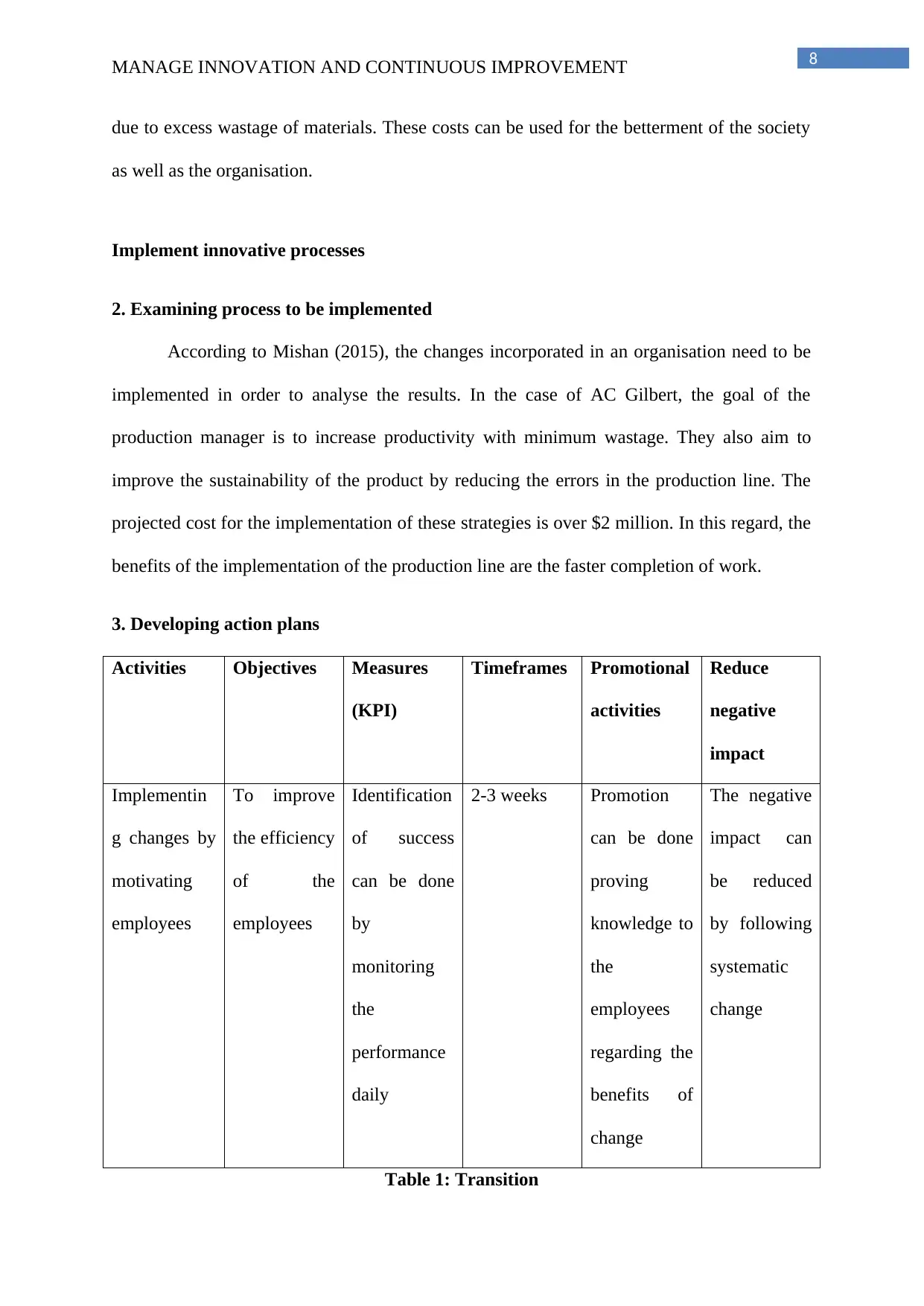
8
MANAGE INNOVATION AND CONTINUOUS IMPROVEMENT
due to excess wastage of materials. These costs can be used for the betterment of the society
as well as the organisation.
Implement innovative processes
2. Examining process to be implemented
According to Mishan (2015), the changes incorporated in an organisation need to be
implemented in order to analyse the results. In the case of AC Gilbert, the goal of the
production manager is to increase productivity with minimum wastage. They also aim to
improve the sustainability of the product by reducing the errors in the production line. The
projected cost for the implementation of these strategies is over $2 million. In this regard, the
benefits of the implementation of the production line are the faster completion of work.
3. Developing action plans
Activities Objectives Measures
(KPI)
Timeframes Promotional
activities
Reduce
negative
impact
Implementin
g changes by
motivating
employees
To improve
the efficiency
of the
employees
Identification
of success
can be done
by
monitoring
the
performance
daily
2-3 weeks Promotion
can be done
proving
knowledge to
the
employees
regarding the
benefits of
change
The negative
impact can
be reduced
by following
systematic
change
Table 1: Transition
MANAGE INNOVATION AND CONTINUOUS IMPROVEMENT
due to excess wastage of materials. These costs can be used for the betterment of the society
as well as the organisation.
Implement innovative processes
2. Examining process to be implemented
According to Mishan (2015), the changes incorporated in an organisation need to be
implemented in order to analyse the results. In the case of AC Gilbert, the goal of the
production manager is to increase productivity with minimum wastage. They also aim to
improve the sustainability of the product by reducing the errors in the production line. The
projected cost for the implementation of these strategies is over $2 million. In this regard, the
benefits of the implementation of the production line are the faster completion of work.
3. Developing action plans
Activities Objectives Measures
(KPI)
Timeframes Promotional
activities
Reduce
negative
impact
Implementin
g changes by
motivating
employees
To improve
the efficiency
of the
employees
Identification
of success
can be done
by
monitoring
the
performance
daily
2-3 weeks Promotion
can be done
proving
knowledge to
the
employees
regarding the
benefits of
change
The negative
impact can
be reduced
by following
systematic
change
Table 1: Transition
⊘ This is a preview!⊘
Do you want full access?
Subscribe today to unlock all pages.

Trusted by 1+ million students worldwide
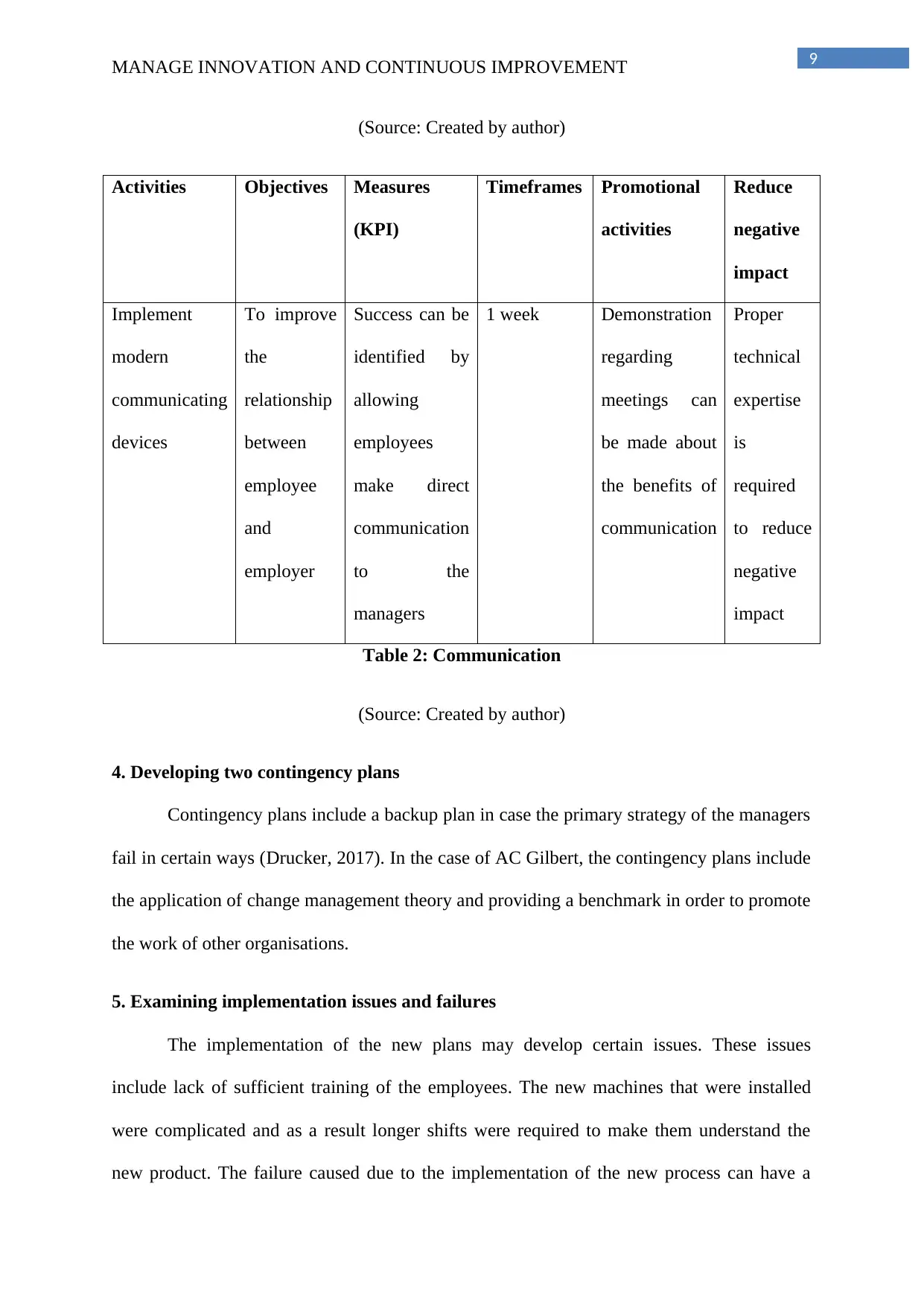
9
MANAGE INNOVATION AND CONTINUOUS IMPROVEMENT
(Source: Created by author)
Activities Objectives Measures
(KPI)
Timeframes Promotional
activities
Reduce
negative
impact
Implement
modern
communicating
devices
To improve
the
relationship
between
employee
and
employer
Success can be
identified by
allowing
employees
make direct
communication
to the
managers
1 week Demonstration
regarding
meetings can
be made about
the benefits of
communication
Proper
technical
expertise
is
required
to reduce
negative
impact
Table 2: Communication
(Source: Created by author)
4. Developing two contingency plans
Contingency plans include a backup plan in case the primary strategy of the managers
fail in certain ways (Drucker, 2017). In the case of AC Gilbert, the contingency plans include
the application of change management theory and providing a benchmark in order to promote
the work of other organisations.
5. Examining implementation issues and failures
The implementation of the new plans may develop certain issues. These issues
include lack of sufficient training of the employees. The new machines that were installed
were complicated and as a result longer shifts were required to make them understand the
new product. The failure caused due to the implementation of the new process can have a
MANAGE INNOVATION AND CONTINUOUS IMPROVEMENT
(Source: Created by author)
Activities Objectives Measures
(KPI)
Timeframes Promotional
activities
Reduce
negative
impact
Implement
modern
communicating
devices
To improve
the
relationship
between
employee
and
employer
Success can be
identified by
allowing
employees
make direct
communication
to the
managers
1 week Demonstration
regarding
meetings can
be made about
the benefits of
communication
Proper
technical
expertise
is
required
to reduce
negative
impact
Table 2: Communication
(Source: Created by author)
4. Developing two contingency plans
Contingency plans include a backup plan in case the primary strategy of the managers
fail in certain ways (Drucker, 2017). In the case of AC Gilbert, the contingency plans include
the application of change management theory and providing a benchmark in order to promote
the work of other organisations.
5. Examining implementation issues and failures
The implementation of the new plans may develop certain issues. These issues
include lack of sufficient training of the employees. The new machines that were installed
were complicated and as a result longer shifts were required to make them understand the
new product. The failure caused due to the implementation of the new process can have a
Paraphrase This Document
Need a fresh take? Get an instant paraphrase of this document with our AI Paraphraser
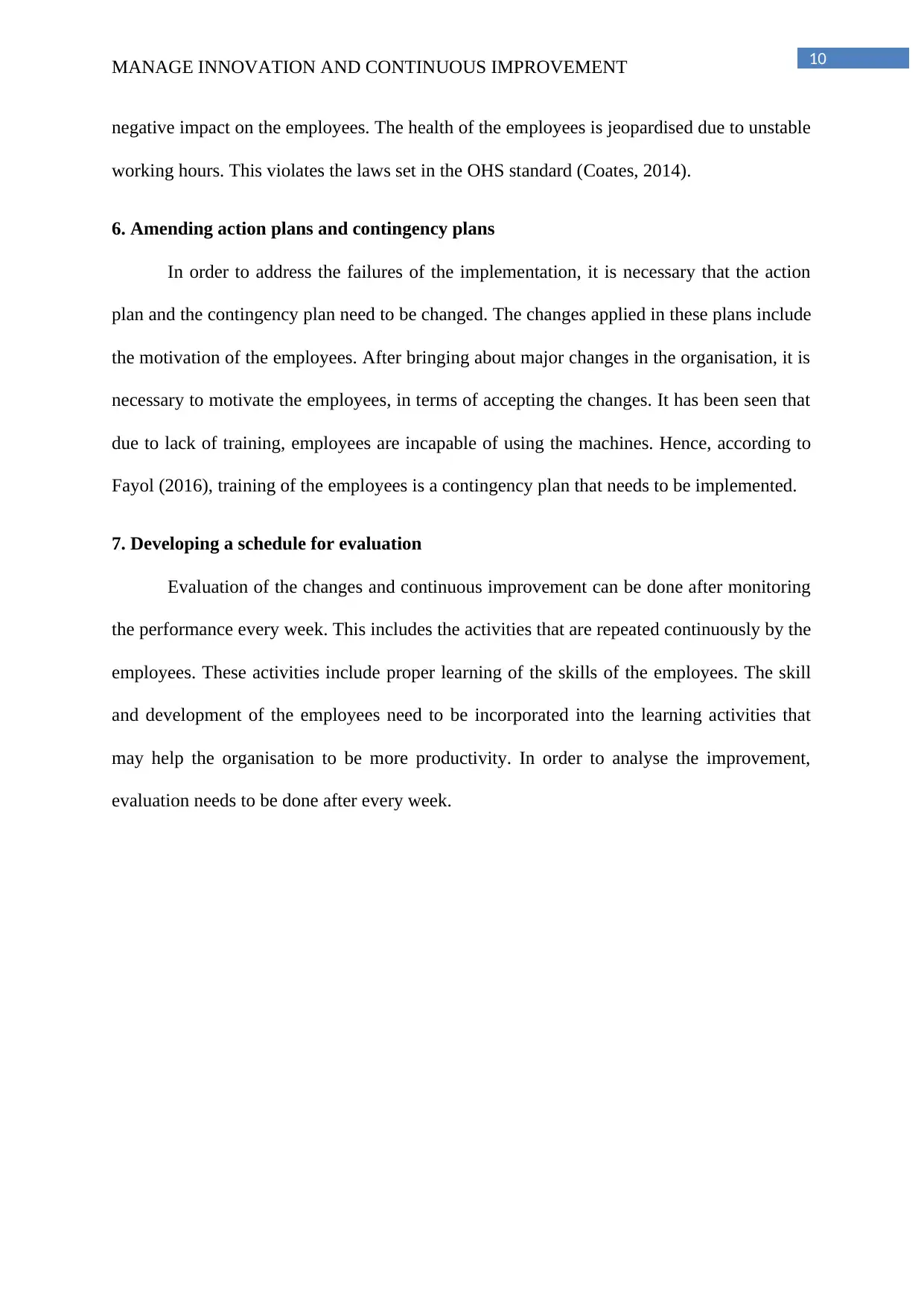
10
MANAGE INNOVATION AND CONTINUOUS IMPROVEMENT
negative impact on the employees. The health of the employees is jeopardised due to unstable
working hours. This violates the laws set in the OHS standard (Coates, 2014).
6. Amending action plans and contingency plans
In order to address the failures of the implementation, it is necessary that the action
plan and the contingency plan need to be changed. The changes applied in these plans include
the motivation of the employees. After bringing about major changes in the organisation, it is
necessary to motivate the employees, in terms of accepting the changes. It has been seen that
due to lack of training, employees are incapable of using the machines. Hence, according to
Fayol (2016), training of the employees is a contingency plan that needs to be implemented.
7. Developing a schedule for evaluation
Evaluation of the changes and continuous improvement can be done after monitoring
the performance every week. This includes the activities that are repeated continuously by the
employees. These activities include proper learning of the skills of the employees. The skill
and development of the employees need to be incorporated into the learning activities that
may help the organisation to be more productivity. In order to analyse the improvement,
evaluation needs to be done after every week.
MANAGE INNOVATION AND CONTINUOUS IMPROVEMENT
negative impact on the employees. The health of the employees is jeopardised due to unstable
working hours. This violates the laws set in the OHS standard (Coates, 2014).
6. Amending action plans and contingency plans
In order to address the failures of the implementation, it is necessary that the action
plan and the contingency plan need to be changed. The changes applied in these plans include
the motivation of the employees. After bringing about major changes in the organisation, it is
necessary to motivate the employees, in terms of accepting the changes. It has been seen that
due to lack of training, employees are incapable of using the machines. Hence, according to
Fayol (2016), training of the employees is a contingency plan that needs to be implemented.
7. Developing a schedule for evaluation
Evaluation of the changes and continuous improvement can be done after monitoring
the performance every week. This includes the activities that are repeated continuously by the
employees. These activities include proper learning of the skills of the employees. The skill
and development of the employees need to be incorporated into the learning activities that
may help the organisation to be more productivity. In order to analyse the improvement,
evaluation needs to be done after every week.
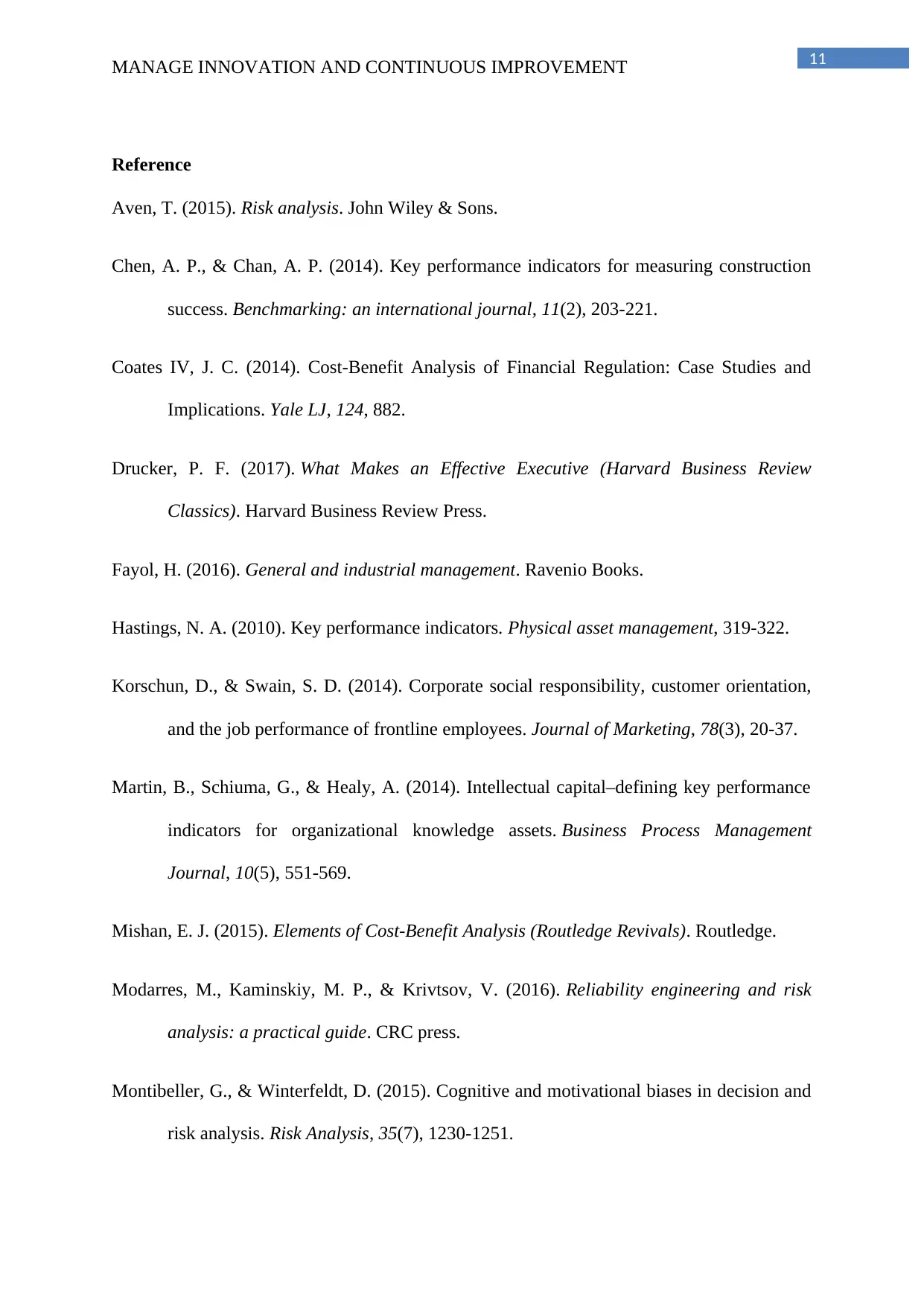
11
MANAGE INNOVATION AND CONTINUOUS IMPROVEMENT
Reference
Aven, T. (2015). Risk analysis. John Wiley & Sons.
Chen, A. P., & Chan, A. P. (2014). Key performance indicators for measuring construction
success. Benchmarking: an international journal, 11(2), 203-221.
Coates IV, J. C. (2014). Cost-Benefit Analysis of Financial Regulation: Case Studies and
Implications. Yale LJ, 124, 882.
Drucker, P. F. (2017). What Makes an Effective Executive (Harvard Business Review
Classics). Harvard Business Review Press.
Fayol, H. (2016). General and industrial management. Ravenio Books.
Hastings, N. A. (2010). Key performance indicators. Physical asset management, 319-322.
Korschun, D., & Swain, S. D. (2014). Corporate social responsibility, customer orientation,
and the job performance of frontline employees. Journal of Marketing, 78(3), 20-37.
Martin, B., Schiuma, G., & Healy, A. (2014). Intellectual capital–defining key performance
indicators for organizational knowledge assets. Business Process Management
Journal, 10(5), 551-569.
Mishan, E. J. (2015). Elements of Cost-Benefit Analysis (Routledge Revivals). Routledge.
Modarres, M., Kaminskiy, M. P., & Krivtsov, V. (2016). Reliability engineering and risk
analysis: a practical guide. CRC press.
Montibeller, G., & Winterfeldt, D. (2015). Cognitive and motivational biases in decision and
risk analysis. Risk Analysis, 35(7), 1230-1251.
MANAGE INNOVATION AND CONTINUOUS IMPROVEMENT
Reference
Aven, T. (2015). Risk analysis. John Wiley & Sons.
Chen, A. P., & Chan, A. P. (2014). Key performance indicators for measuring construction
success. Benchmarking: an international journal, 11(2), 203-221.
Coates IV, J. C. (2014). Cost-Benefit Analysis of Financial Regulation: Case Studies and
Implications. Yale LJ, 124, 882.
Drucker, P. F. (2017). What Makes an Effective Executive (Harvard Business Review
Classics). Harvard Business Review Press.
Fayol, H. (2016). General and industrial management. Ravenio Books.
Hastings, N. A. (2010). Key performance indicators. Physical asset management, 319-322.
Korschun, D., & Swain, S. D. (2014). Corporate social responsibility, customer orientation,
and the job performance of frontline employees. Journal of Marketing, 78(3), 20-37.
Martin, B., Schiuma, G., & Healy, A. (2014). Intellectual capital–defining key performance
indicators for organizational knowledge assets. Business Process Management
Journal, 10(5), 551-569.
Mishan, E. J. (2015). Elements of Cost-Benefit Analysis (Routledge Revivals). Routledge.
Modarres, M., Kaminskiy, M. P., & Krivtsov, V. (2016). Reliability engineering and risk
analysis: a practical guide. CRC press.
Montibeller, G., & Winterfeldt, D. (2015). Cognitive and motivational biases in decision and
risk analysis. Risk Analysis, 35(7), 1230-1251.
⊘ This is a preview!⊘
Do you want full access?
Subscribe today to unlock all pages.

Trusted by 1+ million students worldwide
1 out of 13
Related Documents
Your All-in-One AI-Powered Toolkit for Academic Success.
+13062052269
info@desklib.com
Available 24*7 on WhatsApp / Email
![[object Object]](/_next/static/media/star-bottom.7253800d.svg)
Unlock your academic potential
Copyright © 2020–2025 A2Z Services. All Rights Reserved. Developed and managed by ZUCOL.





